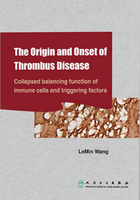
上QQ阅读APP看书,第一时间看更新
2.Main protein components of acute venous thrombus
Although the principle in the treatment of venous and arterial thrombosis is identical,the thrombolytic time window differs largely. Thrombolytic therapy is effective within several hours after onset for arterial thrombosis but as long as several days, two weeks or even longer for venous thrombosis. The mechanism underlying the difference in the thrombolytic time window between venous and arterial thromboses still remains unclear.
Pulmonary artery catheter angiography was performed in a 31-year-old patient who got dyspnea without any definite cause and PE diagnosis was confirmed. The catheter was inserted to the pulmonary artery, and the embolus was obtained for mass spectrographic analysis of thrombus proteins. Results showed that a majority of proteins were less than 130 kDa with great differences in abundance. The proteins with the relative abundance of trace to 34.34% could be observed (Figure 3-2-1).

Figure 3-2-1 Electrophoresis of thrombus proteins of an acute PE patient. The mass spectrographic analysis results are summarized in Table 3-2-1. (American Journal Of Respiratory And Critical Care Medicine,2011,184: 145-146)
Table 3-2-1 The components of thrombus proteins

Mass spectrographic analyses showed that a majority of the proteins were fibrinogen, and the remaining included serum albumin and cytoskeletal proteins.
Early thrombolytic therapy may bring favorable effects [1-3]. Furthermore, some patients can benefit from thrombolytic therapy even 6~14 days after PE [4]. In our experience, when the thrombolytic therapy was applied in patients more than 2 weeks after PE, favorable outcome could still be achieved, although the mechanism underlying the wide thrombolytic time window in PE patients remains unclear. According to the phlebothrombosis theory, in veins the blood flow is slow, and the thrombus is rich in fibrin and red cells, only with a small amount of platelets. Ten days after the onset of acute PE, the embolus was found to be red embolus, flexible, elastic, and fragile. Our mass spectrographic analysis showed that the main component of thrombus in acute PE was fibrinogen, with some serum albumin and cytoskeletal proteins. Fibrinogen makes the embolus fragile, which explains the reason of wide thrombolytic time window and also explains why PE patients with stable hemodynamics may benefit from anticoagulant therapy alone, and interventional thromboclasis is still effective for acute PE patients [5]. The thrombus of VTE in pathology mainly includes red thrombus and mixed thrombus, with a small mount of white thrombus. The protein component of red thrombus in acute PE is mainly fibrinogen, which can convert to fibrin, but this needs some time. This change needing the time may explain why VTE patients may benefit from anticoagulant therapy alone and the reason of wide thrombolytic time window.
(Published: Am J Respir Crit Care Med 2011;184:145-6.)
References
1.Urokinase pulmonary embolism trial. Phase 1 results: a cooperative study. JAMA. 1970 Dec 21;214(12):2163-72.
2.Goldhaber SZ, Haire WD, Feldstein ML, Miller M, Toltzis R, Smith JL, et al. Alteplase versus heparin in acute pulmonary embolism: randomised trial assessing right-ventricular function and pulmonary perfusion. Lancet.1993;341:507-11.
3.Goldhaber SZ, Kessler CM, Heit JA, Elliott CG, Friedenberg WR, Heiselman DE, et al. Recombinant tissue-type plasminogen activator versus a novel dosing regimen of urokinase in acute pulmonary embolism: a randomized controlled multicenter trial. J Am Coll Cardiol. 1992;20:24-30.
4.Daniels LB, Parker JA, Patel SR, Grodstein F, Goldhaber SZ. Relation of duration of symptoms with response to thrombolytic therapy in pulmonary embolism. Am J Cardiol. 1997;80:184-8.
5.Wang L, Wei L, Liu Y, Li X, Guo X, Zhi J, et al. Optional therapeutic strategies based on clinically different types of acute pulmonary embolism. Chin Med J (Engl). 2003;116:849-52.